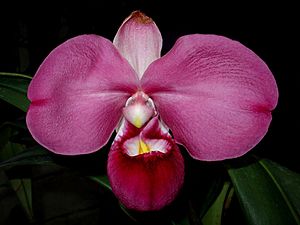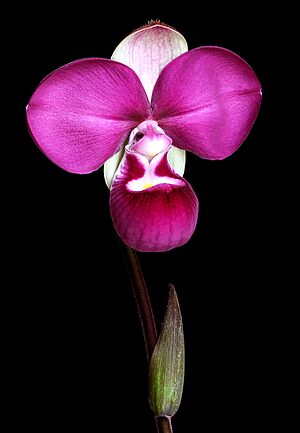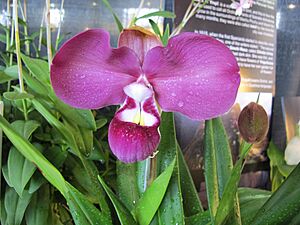Phragmipedium kovachii facts for kids
Quick facts for kids Phragmipedium kovachii |
|
|---|---|
 |
|
| Conservation status | |
| Scientific classification | |
| Genus: |
Phragmipedium
|
| Species: |
kovachii
|
| Synonyms | |
|
Phragmipedium peruvianum Christenson |
|
The Phragmipedium kovachii is a beautiful type of orchid. Scientists first discovered this plant in 2001. It grows naturally in the cloud forests of northern Peru, which are misty, high-altitude forests. This orchid grows on the ground in groups, and its flowers are very showy. They can be pink to purple and grow up to 20 cm (8 in) wide! Sadly, this orchid is now considered critically endangered. This means it is at a very high risk of disappearing from the wild. This is mainly because too many people have collected it illegally.
Contents
What it looks like
Phragmipedium kovachii is an orchid that grows on the ground, not on trees. It forms clumps, meaning many plants grow together in a group. Each plant has short stems with up to nine leaves. These leaves are long and narrow, shiny green, and can be up to 64 cm (25 in) long and 5 cm (2 in) wide. They are thick and have a pointed tip.
The flower stalk grows 20–52 cm (8–20.5 in) tall and usually has just one large flower. This flower can be 10–20 cm (4–8 in) wide. The outer parts of the flower, called sepals, are oval-shaped. They are covered with golden-brown hairs on the outside and are whitish to rose-pink inside. The petals are pink to dark purple and also oval-shaped. They can be up to 6 cm (2.4 in) long and have edges that curl backward.
The most special part of the flower is its cup-shaped "lip" or labellum. This part can be up to 7.5 cm (3 in) long and 4 cm (1.6 in) wide. It is usually purple to fuchsia in color. After the flower blooms, it produces fruits that are like long seed pods, called capsules. These capsules can be up to 10.5 cm (4.1 in) long.
How it was named
The first official description of Phragmipedium kovachii was published in June 2002. It was written by John Atwood and Stig Dalström from the Marie Selby Botanical Gardens. Ricardo Fernandez from the National University of San Marcos Herbarium in Peru also helped.
Soon after, in July 2002, another orchid expert named Eric Christenson published his own description. He gave the plant the name Phragmipedium peruvianum. However, because Atwood, Dalström, and Fernandez published their description first, their name, P. kovachii, became the official one. The name Phragmipedium peruvianum then became a synonym, which is like a different name for the same thing.
At first, scientists placed this orchid in a group called Micropetalum. But later, they decided it was so unique that it needed its own special group, called Schluckebieria.
Where it lives
Phragmipedium kovachii is only found in a very small area of Peru. It grows in just five known spots in the Amazonas and San Martín areas.
This orchid lives in primary montane forests, which are old mountain forests. It grows at high elevations, usually between 1600 and 1950 meters (about 5,250 to 6,400 feet) above sea level. It prefers to grow on limestone cliffs.
The places where it lives get constant rainfall. The soil is rich in organic matter and contains a lot of calcareous material, which means it has calcium. The pH of the soil is usually between 6.8 and 7.1, which is slightly alkaline. The temperature in these areas averages about 26 °C (79 °F) in summer and 18 °C (64 °F) in winter. It rains a lot, with about 1000–1500 mm (40–60 in) of rain each year.
How it lives
Phragmipedium kovachii grows in groups of 15 to 20 plants. They are found on cretaceous limestone cliffs that face south. These cliffs are in valleys that run from east to west.
This orchid is quite picky about its soil. Unlike many other Phragmipedium species, it really likes soils that have a lot of calcium carbonate, about 85.7%. This makes it a "soil specialist," meaning it needs a very specific type of soil to grow well.
Scientists are still not sure which animals pollinate this orchid. However, they think the pollinators must be larger than those for other Phragmipedium species. This is because the orchid's lip, which attracts pollinators, is much bigger. Some experts also believe that the orchid's flower colors might look like those of Tibouchina plants. This could help attract pollinators that are drawn to those colors.
Protecting the species
One of the biggest dangers to Phragmipedium kovachii is "overcollection." This means too many plants are taken from the wild, often illegally. In fact, one place where this orchid grew was completely emptied of plants even before scientists officially described the species. After the description was published, three more locations were also overcollected. It's estimated that 5,000 or more plants have been removed from their natural homes.
This orchid is listed in Appendix I of CITES. CITES is an international agreement that aims to control the trade of endangered plants and animals. However, some people believe that CITES isn't always effective against illegal smuggling. They think it can sometimes make it harder for wild species to enter the legal market.
To help protect P. kovachii and reduce illegal collection, the Peruvian government has taken action. They have given licenses to some plant nurseries. These nurseries are allowed to grow and sell P. kovachii legally.
Because its population has shrunk so much due to overcollection, and because it only lives in a small area, experts are very concerned. Phillip Cribb, an orchid expert from Kew Gardens, and the IUCN have both classified Phragmipedium kovachii as critically endangered. This is the highest risk category before extinction in the wild.
Growing the orchid
If you want to grow Phragmipedium kovachii, it needs a moist growing mix. This mix should have calcium, similar to the soil in its natural habitat. It's important to keep an eye on the pH levels of the soil.
You need to be careful when using fertilizers, especially on young plants. Fertilizers contain salts, which can harm delicate plants. This orchid needs a medium amount of light. It's best to avoid very strong light, especially for young plants. Older plants can handle a bit more sunlight. Since it's an orchid from high mountains, the temperature should be similar to its natural home.
See also
 In Spanish: Phragmipedium kovachii para niños
In Spanish: Phragmipedium kovachii para niños




